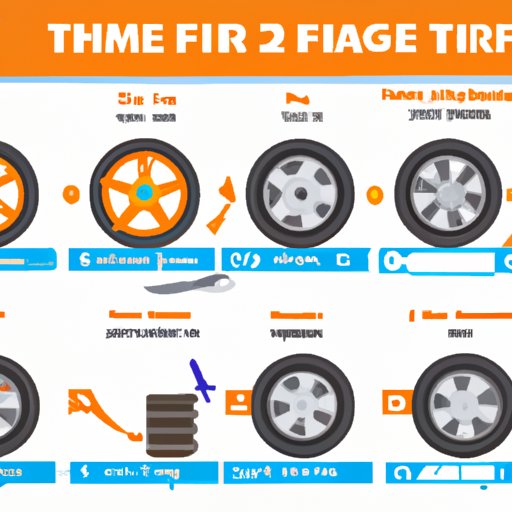
Introduction
Driving along the road when you suddenly hear a loud thump and your car starts to wobble, can be unnerving, especially if you’re in a hurry. One of the common issues drivers face on the road is the existence of flat tires. And while this unexpected event can be frustrating, knowing how to change a flat tire can save you time, money, and provide a sense of security.
This article provides a comprehensive guide on how to change a flat tire, with detailed instructions, a video tutorial, an infographic, a checklist for equipment and tools, and tips and tricks for preventive maintenance.
Step-by-step guide
To change a flat tire, follow these step-by-step instructions:
1. Find a safe and level location –
Park your car in a safe position where other motorists won’t hit it, as a flat tire is often an emergency. Make sure the place is flat with minimal slopes to prevent accidents.
2. Turn on your parking brakes –
Ensure the parked car does not move by turning on the parking brakes, protecting yourself and others.
3. Remove the Wheel Cover –
Check the wheel cover of the damaged tire and loosen it by prying it off using a flat tip screwdriver or a lug wrench. Set it aside for now.
4. Loosen the lug nuts –
Using the lug wrench, loosen the lug nuts by turning them counterclockwise. If you’ve difficulty with stubborn nuts, use force gently by adding your weight to the wrench or have someone stand on it as you loosen it.
5. Place the jack Under the Car –
Consult your vehicle manual for the safe place to position the jack under the car, avoiding the plastic or light metal parts that can easily be damaged. Keep the jack aligned to the lift point, then elevate the car.
6. Remove the Lug Nuts –
Completely remove the lug nuts and place them in a secure location, as they will be needed later.
7. Remove the damaged tire –
Remove the flat tire and be mindful of where you place it. Thoroughly inspect the spare tire before usage, ensuring that it’s well-inflated.
8. Fit the spare tire –
Align the spare tire correctly on the hub, pushing the tire till it fits tightly. Fasten the lug nuts tightly with your hand.
9. Tighten the Lug Nuts –
Slightly tighten each lug nut with the lug wrench, checking to confirm that the tire is correctly centered. Avoid forcing them too hard as you might break the studs.
10. Lower the Vehicle –
Use the jack to lower the vehicle and remove it from under the car slowly.
11. Tighten the Lug Nuts again –
Using a lug wrench, tighten the lug nuts firmly, but not excessively, in a crisscrossing pattern to ensure they are tightened evenly.
12. Replace the Wheel Cover –
Place the wheel cover back on the tire and tighten it with your hands.
Video Tutorial
To further understand the process, here’s a helpful video tutorial for beginners.
Infographics
This infographic presents the step-by-step guide on how to change a flat tire, ensuring that you get the job done right.

Checklist
Before setting out on a journey, you must ensure that you have a spare tire in your vehicle. Also, it is essential to have the necessary equipment and tools.
Here is what you need for changing a flat tire:
– Spare tire- make sure it is correctly inflated.
– Jack- ensure it can lift the car’s weight and is suitable for the car’s size.
– Lug wrench- fits your vehicle’s nuts
– Wheel chocks- for securing the car’s wheels from moving.
– Gloves- for safety purposes
Review the car manual for additional precautions or special specifications that you need to follow.
Tips and Tricks
Now that you know how to change a flat tire let’s share some additional tips for tire inflation and preventive maintenance.
– Regular tire maintenance helps avoid flat tires.
– Maintaining adequate pressure levels in tires will enable you to have a smooth and fuel-efficient drive.
– When inflating your tires, always check for signs of punctures or cracking.
– Uneven wear on tires indicates the need for professional inspection and possible alignment adjustment.
– Carry an emergency tire repair kit, such as tire plugs and an air compressor to avoid getting caught out without the option for tire changes.
Conclusion
A flat tire can be stressful, but knowing how to change it can save time, money, and prevent accidents. We’ve given you a comprehensive guide, complete with videos, infographics, and additional tips to make changing your flat tire easier for you, even if you are a beginner. Before leaving home, remember to conduct a quick check on your tires and ensure that you have the spare tire, jack, lug wrench, wheel chocks, and gloves-check your car manual for additional information. Remember early planning is always the best way to avoid emergencies on the road.





